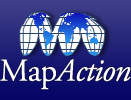
East View Cartographic has been and remains our preferred provider of emergency geospatial services, but we like what we see here at MapAction, which appears to be popular in meeting United Nation (UN) needs, so we show them today as Worth a Look.
Sample Entry:
MapAction has published the first edition of its Field Guide to Humanitarian Mapping. The guide, which is downloadable free, will help aid organisations to use geospatial tools and methods in their work in emergencies. There are tutorials for Google Earth and open-source GIS software. Click here to access the guide.
The guide was written to meet the need for practical, step-by-step advice for aid workers who wish to use free and open-source resources to produce maps both at field and headquarters levels. The first edition contains an introduction to the topic of GIS, followed by chapters focused on the use of two recommended free software tools: Google Earth, and MapWindow. However much of the guidance is also relevant for users of other software. In addition there is a chapter on using GPS to collect data during humanitarian emergencies.
The principal author of the guide, MapAction team member Naomi Morris, commented: “We will be trialing the first edition during a three-month mission to Papua New Guinea in which we will show local organisations how to use these methods for disaster risk reduction mapping. More widely, we will welcome input from all our humanitarian organisations and a second edition of the guide will be issued later this year.”
The guide is available free as a PDF download (118 A5-sized pages) from our Resources page or by clicking here. In case of difficulty contactinfo@mapaction.orgThis e-mail address is being protected from spambots. You need JavaScript enabled to view itand a copy can be emailed. We also welcome user feedback and suggestions for content to be included in the next edition.
Production of the guide was funded by the Dulverton Trust.



